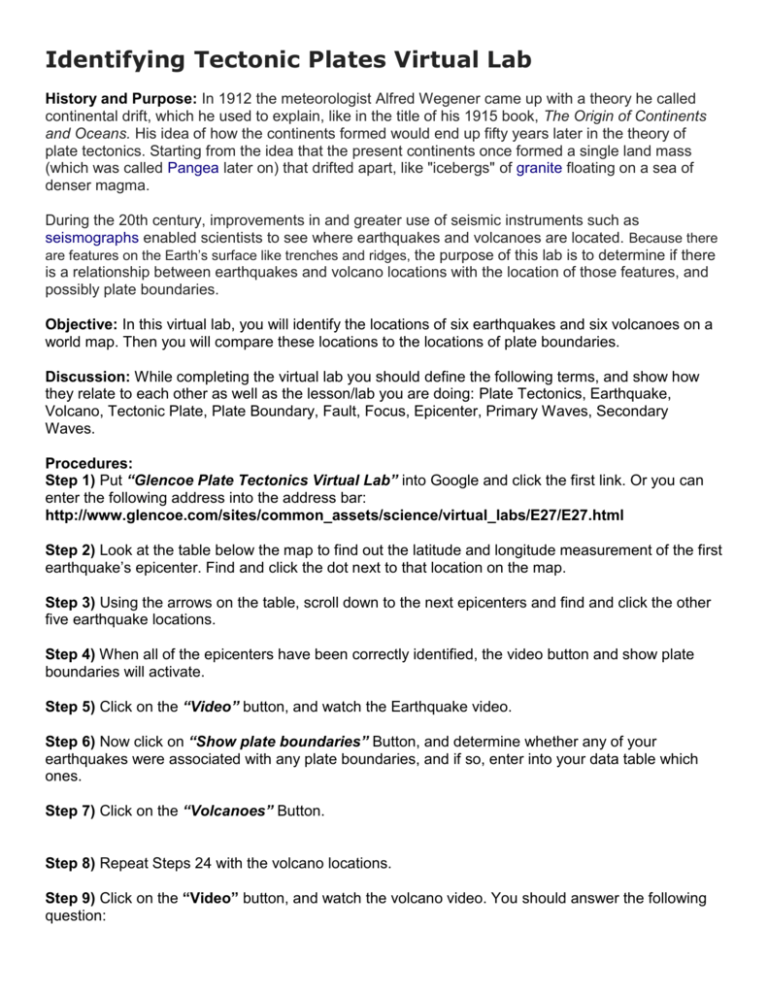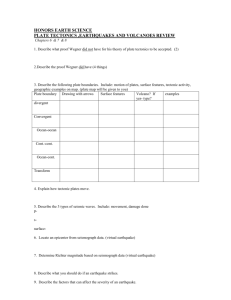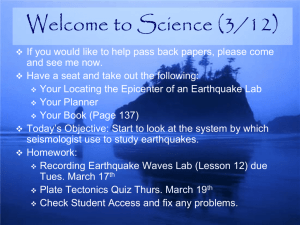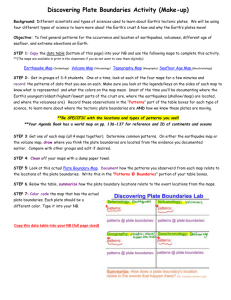Plate Tectonics Virtual Lab Plates tectonics Virtual Lab
advertisement

Identifying Tectonic Plates Virtual Lab History and Purpose: In 1912 the meteorologist Alfred Wegener came up with a theory he called continental drift, which he used to explain, like in the title of his 1915 book, The Origin of Continents and Oceans. His idea of how the continents formed would end up fifty years later in the theory of plate tectonics. Starting from the idea that the present continents once formed a single land mass (which was called Pangea later on) that drifted apart, like "icebergs" of granite floating on a sea of denser magma. During the 20th century, improvements in and greater use of seismic instruments such as seismographs enabled scientists to see where earthquakes and volcanoes are located. Because there are features on the Earth’s surface like trenches and ridges, the purpose of this lab is to determine if there is a relationship between earthquakes and volcano locations with the location of those features, and possibly plate boundaries. Objective: In this virtual lab, you will identify the locations of six earthquakes and six volcanoes on a world map. Then you will compare these locations to the locations of plate boundaries. Discussion: While completing the virtual lab you should define the following terms, and show how they relate to each other as well as the lesson/lab you are doing: Plate Tectonics, Earthquake, Volcano, Tectonic Plate, Plate Boundary, Fault, Focus, Epicenter, Primary Waves, Secondary Waves. Procedures: Step 1) Put “Glencoe Plate Tectonics Virtual Lab” into Google and click the first link. Or you can enter the following address into the address bar: http://www.glencoe.com/sites/common_assets/science/virtual_labs/E27/E27.html Step 2) Look at the table below the map to find out the latitude and longitude measurement of the first earthquake’s epicenter. Find and click the dot next to that location on the map. Step 3) Using the arrows on the table, scroll down to the next epicenters and find and click the other five earthquake locations. Step 4) When all of the epicenters have been correctly identified, the video button and show plate boundaries will activate. Step 5) Click on the “Video” button, and watch the Earthquake video. Step 6) Now click on “Show plate boundaries” Button, and determine whether any of your earthquakes were associated with any plate boundaries, and if so, enter into your data table which ones. Step 7) Click on the “Volcanoes” Button. Step 8) Repeat Steps 24 with the volcano locations. Step 9) Click on the “Video” button, and watch the volcano video. You should answer the following question: Step 10) Now click on “Show plate boundaries” Button, and determine whether any of your volcanoes were associated with any plate boundaries, and if so, enter into your data table which ones. Step 11) Complete the questions at the end as part of your conclusion paragraph. Data Table: Name and/or Location Near Plate Boundary? If so, Which ones? Earthquake 1 Earthquake 2 Earthquake 3 Earthquake 4 Earthquake 5 Volcano 1 Volcano 2 Volcano 3 Volcano 4 Volcano 5 Analysis and Conclusion: The analysis and conclusion is where you discuss whether your hypothesis was right or wrong, and why. You should also answer all the questions below. They must be in complete sentences, answered in order, and labeled with correct questions number. Questions/Analysis: 1. Is there a relationship between the locations of earthquakes epicenters, volcanoes, and plate boundaries? If so, describe the relationship 2. According to the theory of continental drift, all of the world’s continents were once connected as one large landmass and have, over hundreds of millions of years drifted into where they are today. Describe how the results of this activity may support that theory? 3. Why do you think scientists find it easier to predict where an earthquake will occur than it is to predict when an earthquake will occur? 4. The area around the Pacific Place is called the “Pacific Ring of Fire”. Why do you think it is called that? 5. Are all volcanoes located at plate boundaries? If not, why do you think so. (If you don’t know...look it up, and explain. But don’t forget to cite your source of information)







